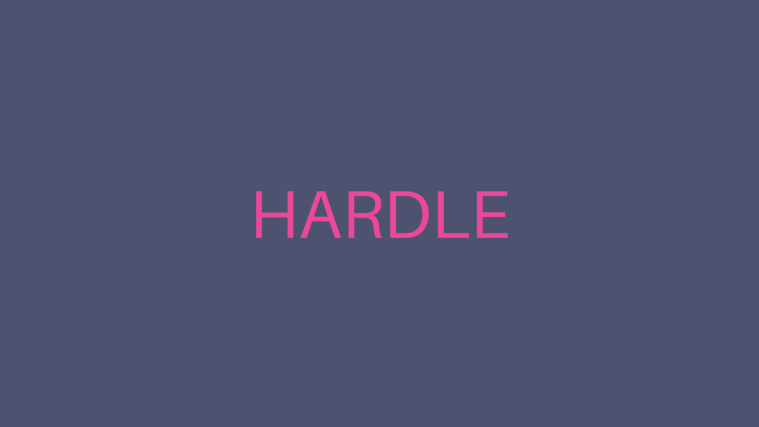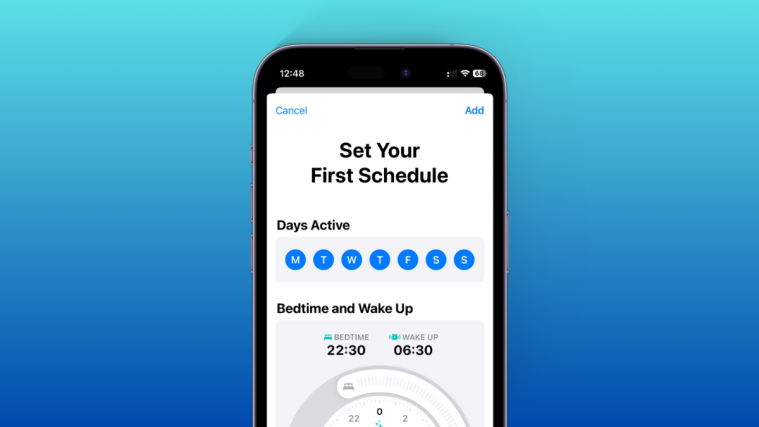With every new Wordle variant, you anticipate more challenges. Hardle, the “Hard Wordle” delivers the challenge to guess the mystery 5-letter word with a tiny flip implemented in the all too familiar “colored-hint” dynamics of the word game sensation, Wordle.
What is the difference that makes Hardle a harder Wordle? In Hardle, you grapple with “pink” and “blue” colored hints that randomly embody different meanings each day as opposed to the steady implication of the colors “green” and “yellow” on Wordle. With this revamped color-coding, the creator Vignesh Venkat pulls you into a two-fold challenge each day — one is to figure out the mystery word, which can only be done if you successfully figure out the color of the day.
With this preface, we shall put the “pink” and “blue” colors on the examination table to see what they represent and why they behave unpredictably in each game.
What colors does Hardle use?
So, you already know what the “green”, “yellow”, and “gray” colors mean on a Wordle grid. The “green” color is used to give feedback to the letters that are all correct (valid letters in the right position). If a letter receives “yellow” feedback, on the other hand, it is the system’s hint to cue you that it is only partially correct (valid letter in the wrong position). “Gray” is to represent a letter that does not occur in the answer or is repeated more times than it actually occurs in the word.

To make the word game harder than it originally is, Hardle’s developer, Venkat, rewired its mechanism to change the standard “green” and “yellow” colored feedback on Wordle to “pink” and “blue” on Hardle. “Gray” denotes the same on both Wordle and Hardle.
Apart from the change in colors, there is also a significant difference in what they imply. Wait, so don’t they also represent all-correct and partially correct letters? Yes, they do but not quite the way you think, though.
Related: What is Hardle? Where and How to Play Hardle
How do colors in Hardle work differently from Wordle?
Pink and blue colors in Hardle deconstruct the attributed meaning of Wordle’s colored hints. In more simple terms, pink and blue colors also tell you which letter is all-correct and which letter is only partially correct. But, they don’t have a fixed designation to deliver this info.
For example, If pink is the feedback color for all-correct letters and blue for the partially correct letters today, tomorrow, the opposite could be the case, i.e., pink for partially correct letters and blue for all-correct letters. The catch is that they swap roles randomly without following any specific pattern.
Take a look at the screenshot below. The S, A, and E got pink feedback in the first guess but blue in the second. In such a situation, you have very little information to ascertain whether the pink S,A, and E are all-correct or if it is the blue S, A, and E that are all correct.
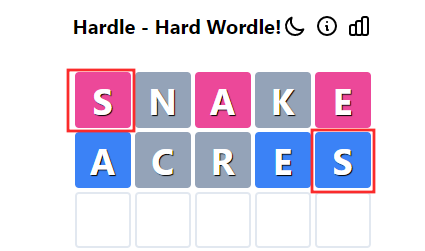
If you are used to diving right into solving the puzzle using the yellow and green feedback given by the Wordle game system, it might have you feeling just a little shell-shocked on a Hardle grid where you can’t instantly understand what the pink and blue colors mean.
A Hardle puzzle can be broken down into 2 parts — figuring out what is the assigned role of pink and blue on the given day, and then using the information to figure out the mystery word of the day. This fluid role-switching between pink and blue on Hardle is the unique element that makes it harder than a typical Wordle puzzle to play.
Thankfully, the creator compensates for the added challenge with 2 additional guesses on Hardle. In Hardle, you get 8 chances (as opposed to 6 chances on Wordle) to solve the daily challenge.
Pink days or Blue days on Hardle: What do they mean?
We already discussed how pink and blue transpose roles without any announcement or indicators in a Hardle game. You cannot predict when pink would represent the all-correct letter and blue would represent the partially correct letter and vice versa. Can you tell which letter is in the right position based on the pink and blue feedback given by the system in the screenshot below? Pink A could be the all-right letter. Or is it the blue A.

Logically, if they changed roles alternatively, then Hardle would be no different from Wordle for a regular player of the fame. That is why unpredictability is the key attribute of role-swapping shown by the pink and blue colors on Hardle. The “color of the day” mystery is the new aspect that sets it apart from Wordle.
So, the question the Hardle grid asks you every day really is — Is it a Pink day today or a Blue day today? It taunts you with the question of whether you can figure out what pink and blue stand for respectively in each game. To solve the main mystery of the game, the mystery word, you have to solve the mystery behind the colors first.
Pink and Blue colors switch: Is there a pattern?
If pink and blue colors swap roles following a certain pattern, like on alternative days, every other day, or follow any predictable pattern, then it would no longer be mysterious for a regular player. That is why the pink and blue colors are designed to switch roles randomly each day.
So, if the color of the day is pink today (for all-correct letters), then it might still be pink the next day, or even the day after that. And then all of a sudden, blue might take over the role to represent all-correct letters in the fourth game. The point is that no one can predict when they will do this and that is the fun and the thrill of playing Hardle.
Understanding Hardle color hints
So, just how do you figure out whether it is a pink day or a blue day? Well, through calculated moves, of course! Your initial moves should not be focused solely on exposing all the valid letters but be a simultaneous attempt to expose the true nature of pink and blue.
To understand what the colors represent, you have no choice but to isolate one valid letter (ideally a consonant) and repeat them in the follow-up guesses. The color that appears the least number of times (usually only once unless it is a repeating letter) corresponding to the letter can be locked in on as the color of the day.
Consonant letters usually repeat less often than vowels but there can be rare cases like “T” in the screenshot below. Then, you will have to make inferences based on the feedback received by other valid letters “S”, “A”, and “E” in the following guesses as played out below.
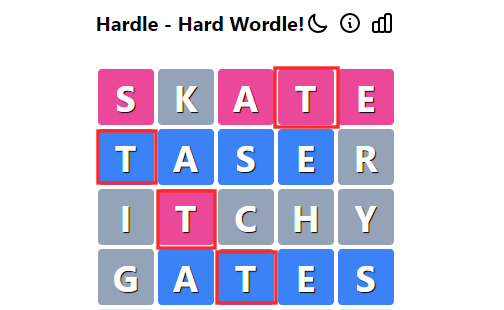
Once you have figured out what pink and blue stand for in that game, they can be treated just the way you take yellow and green feedback on the Wordle grid to unravel the mystery word of the day.
How do colors in the Hardle results grid work?
You might be wondering why the Hardle grid shows the yellow and green tiled emoji grid when these colors do not even appear (let alone have any significance) on a Hardle grid. In fact, the result grid of Hardle is merely a Wordle-esque representation of the game using Wordle’s colors.
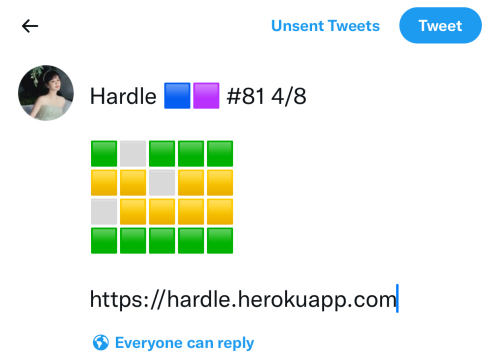
The pink and blue depending on their meaning that day is represented using the corresponding Wordle color on a Hardle result grid. If pink is the color of the day, then, on the result grid that you share on social media, it’d appear “green” and blue would appear “yellow”. When the roles switch next time, they are appropriately treated with the corresponding Wordle-esque color switch.
FAQs
Bet you have some questions about the Hardle colors. We got you covered!
Do the colors on Hardle switch every day?
The pink and blues could swap roles every day, every other day, or follow any random order. So, to answer the question, there is no pattern to the switch. It could be many pink days in a row before blue finally takes over or vice versa. The swapping is completely random that is exactly the intention behind the concept of Hardle colors.
Why are the colors on the Hardle result grid different?
Hardle result grid represents pink and blue according to their current meaning in the Wordle universe. For instance, if pink today on Hardle represents partially correct letters, on the solution grid, they will be shown as yellow, and blue will be shown as green accordingly.
This gives away that Hardle is in fact not different from Wordle apart from the hidden nature of the colors in the game. So, like already mentioned above, Hardle is Wordle with a dual-fold challenge to demystify the colors pink and blue to find the mystery word of the day.
How to guess the color of the day on Hardle easily?
Well, let’s start with the main point, there is no shortcut or cheat to “guess” whether it is a pink or blue day of Hardle. You have to figure it out on your own by making inferences from the system-given feedback.
The best way is to select a valid letter from the get-go, and placing them in different positions to decipher which color recurs more than the other. Excluding cases where a letter is repeated in the word, the chosen color of the day would appear only in one position for the target letter. Click here to learn more about Hardle gameplay.
RELATED

